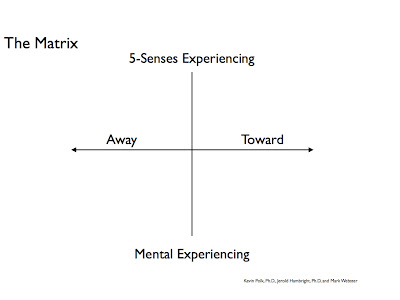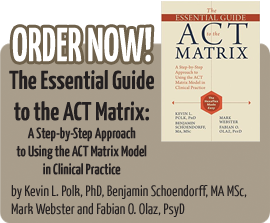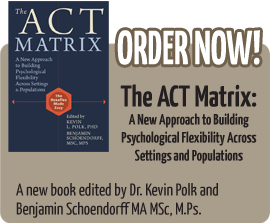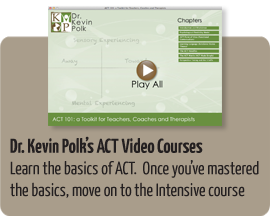Hi Folks,
Just in case you missed the Psychological Flexibility Warm Up… Take up and object and experience it through your five senses. Then put the object down and experiencing the same object in your mind. Then ask, is there a difference between my 5 senses experiencing of the object and my mental experiencing of the object? Then, who is noticing that difference? (“me”)
Then recall what it feels like to move toward something important to you. Then what it feels like to move away from an unwanted mental experience like fear or sadness.
Again, who is noticing the difference between moving toward and moving away? (“me”)
Now we will take a closer look at moving Away…
Look at the lower left quadrant in the diagram above; it’s Mental Experiencing, Away.
That is, you are going to take a look at unwanted mental experiencing that you often move away from.
[Note: Moving away from mental experiencing is not a good or a bad thing. It’s just something you do. Same with moving Toward values is something you do. We all do Toward moves and Away moves every day.]
You start by listing some of the mental experiencing that you move away from. Fear, anger and sadness are three popular ones, but there are many others. Just take a few minutes and list as many as you can come up with. Don’t worry, if you forget some, you can always add more later.
The list you are creating is often called a “Suffering List.” It’s the unwanted mental experiencing that you can end up suffering with.
Now that you have created a Suffering List, its time to list the things in the upper left quadrant (Away Behaviors), that you do to move away from your unwanted mental experiencing. You might avoid going some place to get rid of fear. You might sleep to get rid of sadness. You might meditate to get rid of anxiety. Just list anything you do to move away from, get rid of, or reduce unwanted mental experiencing.
The list you are creating is often called a “Solutions List.” It’s the things you do to try and “Solve” unwanted mental experiencing.
Look over the Solutions List and determine which behaviors work to get rid of or reduce the unwanted mental experiencing for a little while. In other words ask the question, “Is this an effective “Short-Term” solution?“
Now look over the Solutions List and determine which of the behaviors work to permanently get rid of the unwanted mental experiencing. If you are like most people, you will find that the solutions never work for the Long-Term. That’s because mental experiencing always comes back.
The point of this exercise is simple: You are not going to get rid of unwanted mental experiencing. You might do stuff to ignore it or reduce it in the short-term, but the unwanted mental experiencing always comes back. We all do some of this short-term stuff to try and get rid of mental experiencing every day and that’s usually not a problem. It’s only when you start burning a lot of time doing it that it can become what is known as ”struggling with suffering.“
Note: This exercise is not about changing the amount of time you spend Moving Away. It’s simply and exercise to increase your awareness of moving away.
—————————————-
After doing the Values (Moving Toward) and Struggling with Suffering (Moving Away) exercises hopefully you are a little more able to notice the difference between moving toward and moving away. Being able to notice these things helps increase your psychological flexibility.
Homework: Notice when you are moving Away and when you are moving Toward. While noticing moving Toward and moving Away, also notice your 5-senses experiencing AND your Mental Experiencing while moving toward and moving away. In writing this sounds complicated, but in reality you can easily do it. It’s much the same as riding a bicycle.
Below is a video that pertains to this post:
Flexibly Yours,
Kevin





Leave a Reply